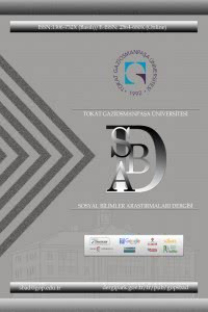Türkiye’deki Eğitim Fakültelerindeki Öğretmen Eğitimi Programları’nda Öğretilen Müfredat Etkisi:Eylem 2006
Öğretmen yetiştirme programlarının kaçınılmaz bir parçası, müfredatların sürekli ve aşamalı iyileştirmesine ilişkin öneriler”dir. Katılımcılar -yöneticiler, uygulayıcılar ve uzman akademisyenlerin her biri, ya da katılımcıların tümü değilse de bir kaçı- tarafından yukarıdan aşağı, aşağıdan yukarıya sunulan ya da etkileşimci ve katılımcı nitelikli öneriler, dikkate alındıkları ve gerçek yaşam koşullarında hayata geçirilmek için yollar bulunduğu koşullarda anlam kazanırlar. Eylem 2006, öğretmen yetiştiren eğitimcileri eğitimli beyinler ve aydınlar olarak müfredat çalışmalarının merkezine koyan ‘öğretilen müfredat’ın görece anlamlı önermelerinin bir örneği olarak, geçerlilik kazanmış ve bu çalışmanın da başat amacı olan çeşitli nedenlerle öğretmen yetiştirme programlarında bir yer edinmiştir. Eylem 2006’nın görece etkileri ve genel mantığı, her ne kadar kapsamlı sonuçlar edinmek için biraz daha zamana gereksinim duyulsa da, öğretmen yetiştirme programlarına paradigma değişiklikleri ve yenilikçi hareketlerle ilgili gelişmeleri izlemenin ötesine geçmeye bir alternatif olması yönüyle ışık tutmaktadır. Çalışma, Eylem 2006’nın ortaya koyduğu öğretmen yetiştiren eğitimcilerin güdüleyici ilgilerinin ve bu yaklaşımın müfredat çalışmalarına getirebileceği birkaç engelleyici durumun ifade edilmesiyle son bulmaktadır
Anahtar Kelimeler:
Eylem 2006, Öğretilen müfredat, Öğretmen yetiştiren eğitimciler, Müfredat geliştirme
Taught Curriculum Effect on Teacher Education Programs at Faculties of Education in Turkey: Action 2006
Inevitable portion of teacher education programs is the continuous and gradual betterment proposals over the curricula. Any sort of propositions with an aim to improve the maintaining programs either recognizing the top-down, bottom-up or interactive and participative suggestions offered by participants -administrators, practitioners and expert academicians, or a combination of several, if not all- make sense especially if they are realized and find ways to get actualized in real life conditions. Action 2006, as an example of comparatively meaningful proposals of ‘taught curriculum’ which puts the teacher educators as intellectuals and educated brains to the center of curricular studies, has proved to be useful and found a place in teacher education programs for several reasons, which is the focus of this study. General reasoning and relative effects of Action 2006, even though it necessitates some more time to get overall results, shed light to the teacher education programs as an alternative to go beyond keeping abreast of the innovations and paradigm shifts. The study finalizes announcing both prompting concerns of teacher educators and mentioning several handicaps that this approach might bring to the curricular studies, which Action 2006 puts forward
Keywords:
Action 2006, Taught curriculum, Teacher educators, Curriculum development.,
___
- Apple, M. W., ve J. A. Beane (2007), Democratic Schools, Heinemann, Portsmouth, NH.
- Glatthorn, A., Boschee, F., & Whitehead, B. (2006), Chapter 1: The nature of curriculum. In Curriculum Leadership: Development and Implementation (pp.3-32). Thousand Oaks, CA:sage.
- Gordon, S. (2004), Curriculum Development. In Professional development for school improvement (pp.236-261). Boston: Allyn & Bacon.
- Hewitt, T. (2006), Chapter 11: Managing and implementing the curriculum. In Understanding and shaping the curriculum (pp. 287-314). Thousand Oaks, CA:Sage.
- Kavak, Y., Aydın, A., & Altun, S. A. (2007), Öğretmen Yetiştirme ve Eğitim Fakülteleri (1982-2007): Öğretmenin Üniversitede Yetiştirilmesinin Değerlendirilmesi. Ankara: Yükseköğretim Kurulu Yayını, Temmuz 2007.
- Murphy, J. (2005), Connecting Teacher Leadership and School Improvement. Thousand Oaks, CA:Sage.
- National Education Statistics:Formal Education 2010-2011, Ministry of National Education, Turkish Statistical Institute.
- Reevess, D. (2006), Chapter 17: Power Standards: How leaders add value to state and national standards. In The Jossey-Bass reader on educational leadership. 2nd ed. (pp. 239-247). San Francisco: Jossey-Bass.
- Richards, J. (2003), Chapter 2: From Syllabus Design to Curriculum Development.In Curriculum Development in Language Teaching 3rded. (pp.23-50). Cambridge University Press:Cambridge.
- Walker, D., & Soltis, J. (1986), Chapter 6: Aims Revisited. In Curriculum and Aims. (pp. 67-83). Teachers College Press:New York.
- Wragg, E. C. (1997), The Cubic Curriculum. Routledge: New York. Türk Eğitim Sisteminin Örgütlenmesi-2011, Milli Eğitim Bakanlığı, Strateji Geliştirme Başkanlığı.
- ÖSYS (Testing, selection and placement center)-university entrance exam applicant data retrieved from; http://www.osym.gov.tr/belge/1-13264/2012-osysye-basvuran-aday- sayilari16012012.html?vurgu=%C3%B6%C4%9Frenci+say%C4%B1s %C4%B1
- Faculties of Education in Turkey retrieved from; http://www.yok.gov.tr/content/view/520/
- Eğitim Fakültelerinde Uygulanacak Yeni Programlar Hakkında Açıklama (Explanation on the New Programs which will be applied at Faculties of Education) retrieved from; http://www.yok.gov.tr/egitim/ogretmen/yeni_programlar_ve_icerik.htm
- Öğretmen Yetiştirme (Teacher Training) retrieved from; http://www.yok.gov.tr/egitim/ogretmen/ogretmen.htm
- Türk Yükseköğretiminin Bugünkü Durumu, Rapor 2005 (Current Situation of Higher Education in Turkey, Report 2005) retrieved from; http://www.yok.gov.tr/egitim/raporlar/raporlar.htm
- ISSN: 1306-732X
- Yayın Aralığı: Yılda 2 Sayı
- Başlangıç: 2006
- Yayıncı: Gaziosmanpaşa Üniversitesi Sosyal Bilimler Enstitüsü
Sayıdaki Diğer Makaleler
Performans Değerlemede Analitik Hiyerarşi Prosesi (AHP) Uygulamaları
Okuma Eğitimi Üzerine Bir Kaynakça Denemesi
Mesut BULUT, Salih ORHAN, Abdulkadir KIRBAŞ
Tokat İli Merkez İlçede Tüketicilerin Kredi Kartı Kullanımı Üzerine Bir Araştırma
Shakespeare’in Oyunlarında Adaletin Tecellisini Etkileyen Faktörler
93 Harbi Sonrasında Yaşanan Göçler ve Neticeleri
İlköğretim II. Kademe Öğrencilerinin Dua Anlayışlarının Cinsiyet Değişkeni Açısından İncelenmesi
Cenk AKAY, Tuğba YANPAR YELKEN
Kanada’daki Sosyal Bilgiler Programlarında Medya Okuryazarlığı Eğitimi
